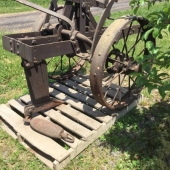


Larry Streeter wrote:This may be of benefit to some.
https://onpasture.com/2013/06/17/keyline-plowing-what-is-it-does-it-work/

Ken Peavey wrote:I've got a Lowline Black Angus bull in the back field. He's 8 years old, fully grown, and is lower than my belt at the shoulder, tipping the scales at about 1000#. There small size means less tearing of the sod. He's as gentle as a kitten, the breed being bred for docility. Lowlines will put on marbled beef on pasture alone, with a carcass yield of 75%. The back field is about 2.5 acres with some woods in there. I offer him hay, about 4 round bales will get him through the cold season in northern Florida. Their small size means a small area is all that is needed for each animal. The result is more meat per acre than most other breeds. Calves come in around 45 pounds, so calving is much easier on the ladies. Bred with a normal sized cow for the first calf presents a high survival rate for the cow and the calf. They can be an expensive breed, Bull, pictured below would command $1200-1500, while a cow of breeding age can draw $1800-2500 and up. A calf will run you a grand. I picked up this handsome fellow for $600 with delivery as the owner had to find a home for him or install fence which he could not afford at the time. He was cheaper than a lawn mower and can keep up with the back field most of the time.

Julia Winter wrote:Instant pot is just a fancy pressure cooker/multicooker but it seems like a great idea, especially for people who don't already have a good pressure cooker. It would also be great for anyone with a small kitchen.
Pressure cookers make the best bone broth! They extract ALL the gelatin from cartilage.
When I'm cooking a tough roast, I will usually fry up onions and load them into my slow cooker. Then I will put more fat in the pan and brown all the surfaces of the meat. Then the meat goes into the slow cooker and some liquid is used to cover it (fruit juice can be really good). The last time I did this, chunks of sweet potatoes and parsnips went in as well. Carrots and regular potatoes are more traditional.




